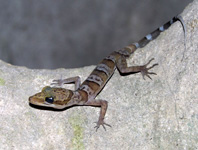Abstract
A nematode from the genus Steinernema was isolated in Zulia state (North-western, Venezuela). Morphological, morphometric and molecular studies indicated that this nematode belongs to the “bicornutum” group and is described herein as Steinernema goweni n. sp. Steinernema goweni n. sp. is characterised by morphometrics of its infective juveniles, with body length 640 (531–719) µm, pharynx length of 119 (109–126) µm, tail of 67 (59–89) µm, c ratio = 9 (6–11) and E% = 77 (48–94). First generation male specimens can be recognised by the shape and size of spicules (55 (50–57) µm long) and gubernaculum (35 (30–40) µm long), and %D value 42 (28–59), which is at the lower limit within the “bicornutum” group. The number of genital papillae in males is also distinctive for S. goweni n. sp. presenting up to 27 (13 pairs + 1) papillae in 15% of specimens. The phasmids can be seen in scanning electron microscopy in all stages, characters not previously reported within the “bicornutum” group. Phylogenetic analyses of the “bicornutum” group based on both ITS and D2D3 regions showed a clear separation of S. goweni n. sp. from the other species. In both analyses S. goweni n. sp. formed a strongly supported group of American species.
References
Adams, B.J. (1998) Species concept and the evolutionary paradigm in modern nematology. Journal of Nematology, 30, 1–21.
Bedding, R.A. & Akhurst, R.J. (1975) A simple technique for the detection of insect parasitic rhabditid nematodes in soil. Nematologica, 21, 109–110.
http://dx.doi.org/10.1163/187529275X00419Burnell, A.M. & Stock, S.P. (2000) Heterorhabditis, Steinernema and their bacterial symbionts—lethal pathogens of insects. Nematology, 2, 31–42.
http://dx.doi.org/10.1163/156854100508872Courtney, W.D., Polley, D. & Miller, V.L. (1955) TAF, an improved fixative in nematode technique. Plant Disease Reporter, 39, 570–571.
Griffin, C.T., Downes, M.J. & Block, W. (1990) Tests of Antarctic soils for insect parasitic nematodes. Antarctic Science, 2, 221–222.
http://dx.doi.org/10.1017/S095410209000030XKaya, H., Aguillera, M.M., Alumai, A., Choo, H.Y., De la Torre, M., Fodor, A., Ganguly, S., Hazir, S., Lakatos, T. & Pye, A. (2006) Status of entomopathogenic nematodes and their symbiotic bacteria from selected countries or regions of the world. Biological Control, 38, 134–155.
http://dx.doi.org/10.1016/j.biocontrol.2005.11.004López-Núñez, J.C., Plichta, K., Góngora-Botero, C.E. & Stock, S.P. (2008) A new entomopathogenic nematode, Steinernema colombiense n. sp. (Nematoda: Steinernematidae), from Colombia. Nematology, 10, 561–574.
http://dx.doi.org/10.1163/156854108784513879Mráček, Z., Hernández, E.A. & Boemare, N.E. (1994) Steinernema cubana sp. n. (Nematoda: Rhabditida: Steinernematidae) and the preliminary characterization of its associated bacterium. Journal of Invertebrate Pathology, 64, 123–129.
http://dx.doi.org/10.1006/jipa.1994.1080Mráček Z., Půža, V. & Nermu, J. (2014) Steinernema poinari sp. n. (Nematoda: Steinernematidae) a new entomopathogenic nematode from Czech Republic. Zootaxa, 3760 (3), 336–350.
http://dx.doi.org/10.11646/zootaxa.3760.3.2Nei, M. & Kumar, S. (2000) Molecular evolution and phylogenetics. Oxford University Press, New York, 333 pp.
Nguyen, K.B. (2007) Methodology, morphology and identification. In: Nguyen, K.B. & Hunt, D.J. (Eds.), Entomopathogenic nematodes: systematics, phylogeny and bacterial symbionts. Nematology Monographs and Perspectives. Vol. 5. Brill, Leiden, pp. 59–119. (Series editors: Hunt, D.J. & Perry, R.N.)
Nguyen, K.B. & Smart, G.C. (1995) Scanning electron microscope studies of Steinernema glaseri (Nematoda: Steinernematidae). Nematologica, 41, 183–190.
http://dx.doi.org/10.1163/003925995X00152Nguyen, K.B. & Smart, G.C. (1997) Scanning electron microscope studies of spicules and gubernacula of Steinernema spp. (Nemata: Steinernematidae). Nematologica, 43, 465–480.
http://dx.doi.org/10.1163/005125997X00066Román, J. & Figueroa, W. (1994) Steinernema puertoricensis n. sp. (Rhabditida: Steinernematidae), a new entomopathogenic nematode from Puerto Rico. Journal of Agriculture, University of Puerto Rico, 78, 167–175.
Půža, V., Chundelová, D., Nermuť, J., Žurovcová, M., Mráček, Z. (2015) Intra-individual variability of ITS region in entomopathogenic nematodes (Steinernematidae: Nematoda): implications for their taxonomy. Biocontrol, 60, 547–554.
http://dx.doi.org/10.1007/s10526-015-9664-5Rzhetsky, A. & Nei, M. (1992), A simple method for estimating and testing minimum evolution trees. Molecular Biology and Evolution, 9, 945–967.
Saitou, N. & Nei, M. (1987) The neighbor-joining method: A new method for reconstructing phylogenetic trees. Molecular Biology and Evolution, 4, 406–425.
San-Blas, E. (2013) Progress on entomopathogenic nematology research: A bibliometric study of the last three decades: 1980-2010. Biological Control, 66, 102–124.
http://dx.doi.org/10.1016/j.biocontrol.2013.04.002San-Blas, E., Portillo, E., Nermuť, J., Půža, V. & Morales-Montero, P. (2015a) Steinernema papillatum n. sp. (Rhabditida: Steinernematidae), a new entomopathogenic nematode from Venezuela. Nematology, 17, 1081–1097.
http://dx.doi.org/10.1163/15685411-00002925San-Blas, E., Rosales, C. & Torres, A. (2015b) Entomopathogenic nematodes in tropical agriculture: current uses and their future in Venezuela. In: Campos-Herrera, R. (Ed.), Nematode pathogenesis of insects and other pests - ecology and applied technologies for sustainable plant and crop protection. Springer International Publishing, Switzerland, pp. 365–389.
http://dx.doi.org/10.1007/978-3-319-18266-7_15Tamura, K., Stecher, G., Peterson, D., Filipski, A. & Kumar, S. (2013) MEGA6: Molecular evolutionary genetics analysis version 6.0. Molecular Biology and Evolution, 30, 2725–2729.
http://dx.doi.org/10.1093/molbev/mst197Uribe-Lorío, L., Mora, M. & Stock, S.P. (2007) Steinernema costaricense n. sp. and S. puntauvense n. sp. (Rhabditida: Steinernematidae), two new entomopathogenic nematodes from Costa Rica. Systematic Parasitology, 68, 167–182.
http://dx.doi.org/10.1007/s11230-007-9098-2Vrain, T.C., Wakarchuk, D.A., Levesque, A.C. & Hamilton, R.I. (1992) Intraspecific rDNA restriction fragment length polymorphism in the Xiphinema americanum group. Fundamental and Applied Nematology, 15, 563–73.
White, G.F. (1927) A method for obtaining infective nematode from cultures. Science, 66, 302–303.
http://dx.doi.org/10.1126/science.66.1709.302-a

